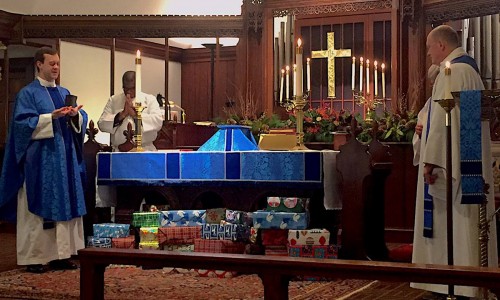Just two days ago, we reported on the historic meeting in Sweden between Pope Francis and leaders of the Lutheran World Federation jointly celebrating the 499th Anniversary of the protestant reformation begun by Martin Luther. That meeting along with other recent developments has many hoping that Lutherans and Roman Catholics may be able to share communion in the near future. Meanwhile, the Evangelical Lutheran Church in America (ELCA), the largest Lutheran body in the United States, and the Episcopal Church have been in full communion since approval of the 1999 agreement, Called to Common Mission. That relationship has resulted in much Lutheran-Episcopal cooperation all across the church, including the formation of joint Lutheran-Episcopal congregations.
A year ago, Church of the Nativity Episcopal And Holy Comforter Lutheran in Baltimore, MD began worshiping together as the Churches of the Nativity and Holy Comforter. But beginning next Sunday, they will become the singular Church of the Nativity and Holy Comforter after celebrating a year of worshiping together. The congregations’ members, jokingly refer to themselves as “Lutherpalians.”
“It seems like we’ve been together forever,” enthused the Rev. Dr. David W. Eisenhuth, Holy Comforter’s pastor. “We now incorporate elements of the liturgies and hymns from both denominational traditions in a way that seems very natural. We are one church now, so we are losing the ‘es.’” The logo will get an update as well.
The Rev. T. Stewart Lucas, Nativity’s Rector, agreed. “Looking back, I guess I’m surprised that the skeptics gave it a chance, but they did,” he explained. “But, when you are both grounded in the importance of worship, the scriptures and prayer, you understand that these are the things that really matter. Everything else is secondary.”
That’s not to suggest there weren’t some hiccups along the way in combining the two congregations. “We had to counter the battle cry that ‘We’ve always done it this way’,” said Pastor Eisenhuth.
For example, the celebration of the Holy Eucharist, or communion, was an early test of the congregations’ resolve. Holy Comforter traditionally had used leavened bread and offered wine or grape juice by chalice or tiny cups, while Nativity studiously used unleavened wafers and distributed only wine by chalice for The Lord’s Supper.
The changes proved too difficult for a few members most committed to Episcopal or Lutheran orthodoxy or “denominationalism.” They have chosen to worship elsewhere. Their places have been filled by new members to Nativity and Holy Comforter, attracted by the friendliness of the joint congregation, where people of different racial, ethnic and economic backgrounds and sexual identities are welcomed.
The two congregations maintain their status as separate legal entities. But, in almost every other aspect, they worship and minister together as one church body. Members of both congregations sing in the choir, handle the flower arrangements, serve on the Altar Guild, and share duties as ushers. Holy Comforter members stepped up to help at Nativity’s Annual Spring Fair, supporting a tradition that has continued for decades. Nativity members brought their sewing skills to Holy Comforter’s Christian Action Group, which makes beautiful quilts for distribution to the homeless.
Attendance at Sunday worship services has roughly doubled what it had been prior to the partnership. “It feels good to have more people in the pews. We are more energetic and more creative as a combined church body,” noted Rector Lucas. “Two churches that were dwindling chose to come together. Now, we are rising.”
The unusual pairing of churches from different denominations has garnered the attention of national church groups, not only Episcopal and Lutheran but other mainstream Christian denominations facing some of the same problems that had challenged Nativity and Holy Comforter. Teams of church leaders and academics have visited to learn firsthand what is going on in North Baltimore.
“We have been a beacon for other churches that are struggling,” said Rector Lucas. “Now we are looking out into the community to see where God wants us to do more ministry. We are about to purchase the 8000 square foot office building and parking lot next door. Who knows what God has in store for us next?”
Pastor Eisenhuth added, “We had members who said they wanted a Lutheran worship service. What does that mean? Increasingly, denominations will become passé and not that important. We needed to overcome fear of the future, fear of change.”
Both clergymen credited their respective Bishops, from the Episcopal Diocese of Maryland and the Delaware-Maryland Synod of the Evangelical Lutheran Church in America, for permitting this experimental partnership to go forward.

